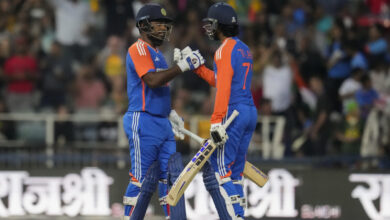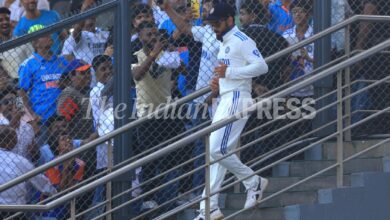Wicketkeepers’ race for T20 World Cup: Jitesh has promise as a finisher, Samson’s best spot is at No.3, Pant needs to up strike rate | Ipl News

Days ahead of the IPL 2024 season, the BCCI passed the green signal for Rishabh Pant to resume duties as “wicket-keeper batter” with the Delhi Capitals.Before the formal announcement, BCCI secretary Jay Shah sounded a word of optimism that could spike interest during the tournament. “If he can play the T20 World Cup for India, that will be a big thing for us. He is a big asset for us,” Shah told reporters.
In short, it spoke volumes about the void of the last 14 months and India’s failure to settle down on wicketkeeping options in Pant’s absence.
As a third T20 World Cup within four years is set to commence a week after the IPL, India’s designated wicketkeeper remains undecided.
Heading into the IPL, a handful of options pop up with varying predicaments and opportunities.
Pant’s need to up strike rate
Pant’s IPL progression was rapid with his hard-hitting capacity cementing his status as one of the league’s leading keeper-batter’s between 2016 and 2019. However, the leadership tag, coupled with the glovework, mopped up some runs off his bat in his last three seasons (2020-22).
While his strike rate meandered in the mid-120s in 2020 and 2021, he catapulted it back into the 150s in 2022, the trade-off being half-centuries.
It may be partially inappropriate to gauge his overall numbers given his unfortunate 14-month absence, but worth recalling that Pant has not necessarily set the stage on fire in T20Is as he has across conditions in Test cricket – his overall average stands at 22.43 with a 126.37 strike rate. 42 of his 56 T20I innings have come at no.4 and 5, accumulating 771 runs at 23.36 and a 124.95 strike-rate — the lowest among all batters who have played in those slots in at least 40 innings.
Pant has not nearly excelled as a finisher and if he is bound to return to the Indian side as the leading wicketkeeper, he is likely to be slotted at 5 – below the likes of a probable Rohit-Jaiswal-Kohli-Suryakumar quartet and above Hardik Pandya and another finisher/all-rounder at seven.
However, Pant’s fitness levels will be tested during a home and away IPL and it waits to be seen how his knees hold up.
Is there space for Rahul in the top-4?
In a bid to revive his T20I fortunes, Rahul has been challenged to don a role that he has rarely applied across an 11-year T20 career – a wicketkeeper and middle-order bat. Across 199 T20 innings, Rahul has only played 21 innings at 4 and 5 — the only likely slots the Karnataka batter would receive if he makes the cut for the World Cup on the back of a solid IPL campaign. With his latest quadriceps setback, Rahul has also been asked to play as a special batter the BCCI in the initial games before taking the gloves.
Rahul last featured in a T20 in May 2023. In the period since, the 32-year-old has gone on to cement his slot in the middle-order for India in ODIs during the home World Cup and excelled in the position in Tests, briefly marred his injury concerns.
Rahul exhibits a different range when he plays in the middle-order, evident in his limited T20 stints at those slots. In 14 innings between no.3 and 4 for India in T20Is, Rahul notched up two centuries — only bettered Suryakumar Yadav and Glenn Maxwell with four apiece across their careers.
Across all T20 games, Rahul’s best average (49.08) and strike rate (139.90) has been achieved when he bats at no.4
Jitesh, potential finisher
In his brief stint with the IPL and team India thus far, Jitesh Sharma has held promise in his role as a designated hitter/finisher. The Punjab Kings’ recent policy of emphasizing range-hitting has also enabled Jitesh to slot in naturally with the bat besides his utility behind the stumps.
His T20I numbers are nascent with only three outings of significance, where he has played more than 10 deliveries batting at number six. While he may need to seal more knocks in Indian colours, the absence of Pant, varying concerns with Ishan Kishan and Rahul, and Sanju Samson’s inconsencies, have put Jitesh as the frontrunner for the World Cup for now.
His adeptness to take on both spin and pace in equal measure keeps him ahead of a few of his peers. In 24 IPL innings, Jitesh has amassed 342 runs against pace at 169.30 and 201 against spin, at a wholesome strike rate of 144.60.
Samson best at No.3
With Kishan’s plunge down the pecking order, Samson was in contention to grab his chance in India’s series against Afghanan in January. However, an impetuous mimed pull in his only outing resulted in a golden duck with India suffering a top-order wobble in Bengaluru. While chances have been few and far between, Samson has failed to click in a middle-order role for India. In his last nine T20I outings, Samson has batted at slots 4-5-6 with a best of 40 against Ireland.
Samson’s success in the IPL though has come higher up at number three, a spot defined Virat Kohli in T20Is and Suryakumar in his absence. While Samson may come across as an inconsent bat, he leads the charts among all wicket-keepers since 2020 with 1526 runs, nearly 90 percent (1360) of which have come at no. 3. Samson has also succeeded in countering spin with good effect in this period, aggregating 746 runs at an average of 46.62 and a 155-plus strike rate – the best returns among all non-openers. However, it would be nothing short of an extraordinary season that can put him on the plane to the USA.
The outlier, Jurel
It will be a managerial punt on temperament and his finishing skills that would propel Dhruv Jurel into the T20 World Cup squad following a fruitful IPL season – like his entry into the Indian Test team.The choice of wicket keeper will play a crucial role in shaping India’s batting-order. If India hold on to a top-order trio of Rohit-Jaiswal-Kohli, Jurel could be one of two contenders for the finisher-cum-keeper role along with Jitesh.
Samson, Rahul, and Pant will thus vie for a higher slot in the order, at best no. 5, with Hardik Pandya and a potential Rinku Singh shouldering the finishing duties.







